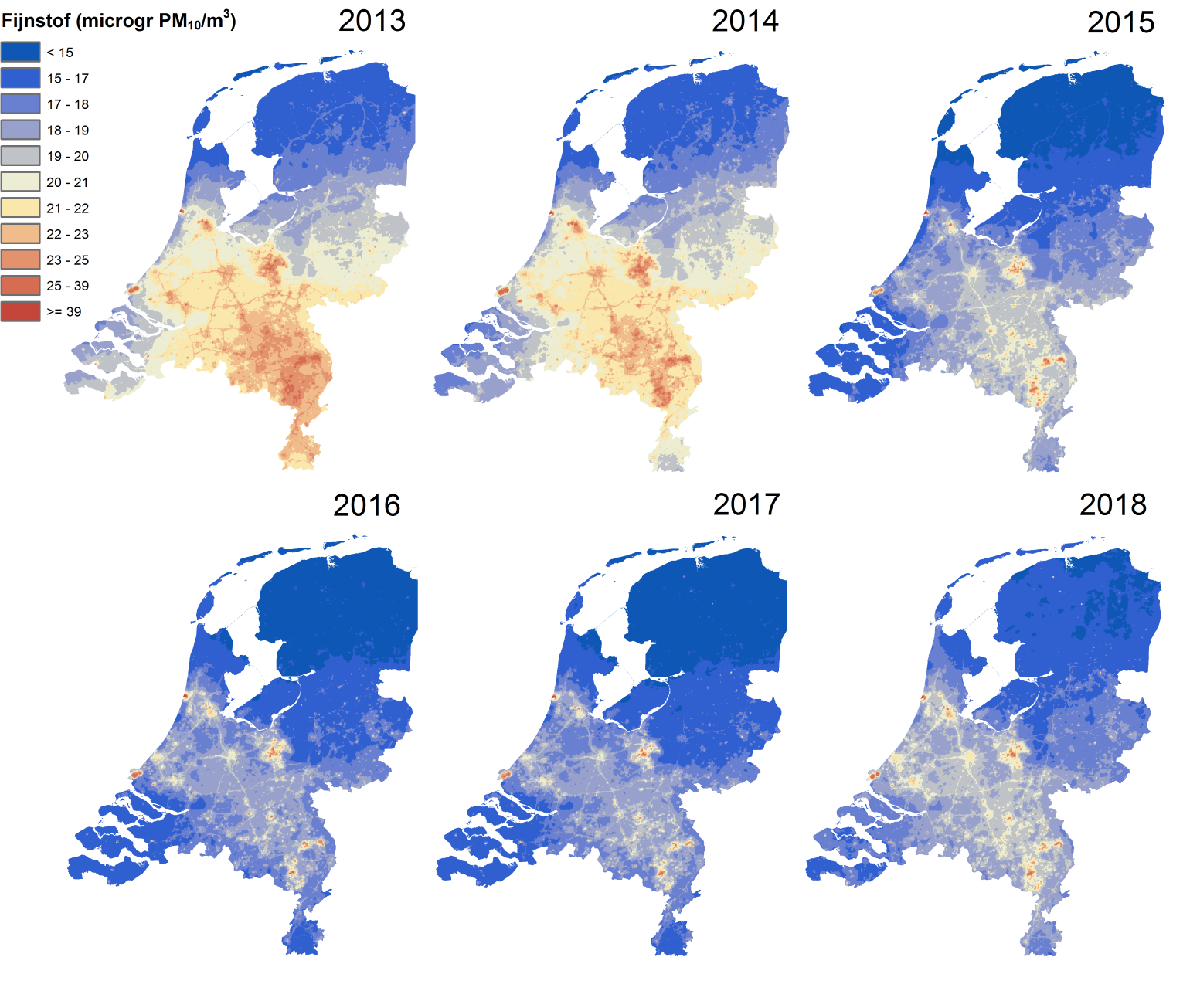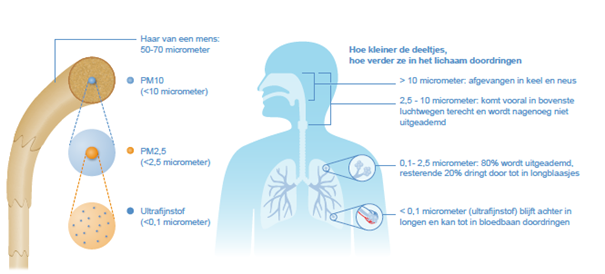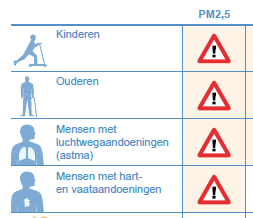Particulate matter, also known as PM, is a complex mixture of extremely small particles and liquid droplets in the air. Some of the particulate matter comes from natural sources such as windblown dust and sea salt. Almost 75- 80% of particulate matter levels in the air is caused by human activity. Particulate matter is produced by, for example, industrial combustion processes and traffic, the transshipment of bulk goods, livestock farming, wood-burning stoves and cigarette smoke.
Particles that are smaller than 10 micrometres (1 micrometre is one thousand times smaller than 1 millimetre) are called PM10. The particles can differ in scale and size, as well as in chemical composition. Particles that are smaller than 2.5 micrometres are referred to as PM2.5. Recently more and more attention is being paid to the even smaller particles (ultrafine particles) because these appear to be more harmful than PM10 and PM2.5 particles. The diagram shows that the health effects depend on the size of the particles.
Soot
Soot is an element of particulate matter and is formed when ultrafine particles clump together. It is produced during the (incomplete) combustion of diesel and other fuels. More and more diesel cars have been fitted with filters which effectively reduce the amount of soot emitted. The expectation is therefore that the quantity of soot in the air will continue to decrease in the coming years. Wood-burning stoves will probably become the greatest source of soot, now that the contribution from traffic is declining.
The measured annual average levels of particulate matter in the air have halved during the past 20 years halved during the past 20 years due to traffic interventions and industry and the energy measures. In 2016 the limit value for particulate matter was still being exceeded in some places near large cattle farms.
Concentraties fijnstof in Nederland (PM10) vanaf 2013.
Particulate matter is unhealthy
Particular matter is a health hazard. In the Netherlands people tend to die several days or months earlier due to short-term exposure to particulate matter. The people in question are primarily elderly people and people with coronary or lung diseases. There is no safe level because particulate matter is also harmful in low concentrations. However, in that case the scale of the effects is much less than at higher concentrations.
The size of the different types of particulate matter and where they end up in the body. (Source: Health Council of the Netherlands)
Health effects of particulate matter
Short-term (for one or more days) high exposure to particulate air pollution has an effect on the health of people who are already vulnerable to such pollution. They may be suffering from coughs and tightness of chest and worsening of respiratory complaints and temporary reductions in lung function. Children, parents and people with existing respiratory disorders or cardiovascular diseases are the most vulnerable groups (see diagram). The symptoms usually disappear as soon as the concentration of particulate matter in the air drops. A correlation is also believed to exist with the increased daily mortality from cardiovascular and respiratory diseases.
As a result of the decreasing particulate matter levels since the start of the 1990s, early mortality due to short-term peak exposure has also been decreasing. It is estimated that more than 3,000 people died prematurely each year in the early 1990s as a consequence of a short-term peak exposure to particulate matter, compared to approximately 1,600 in 2013. The people in question were primarily elderly people and people with coronary or lung diseases. (Source: Environmental Data Compendium)
Long-term exposure to particulate matter can have effects on people's health, such as reduced lung function and exacerbation of respiratory complaints. People can also die prematurely due primarily to respiratory complaints and cardiovascular diseases. The lives of Dutch people who have experienced long-term exposure to particulate matter will be reduced by approximately 9 months compared to a particulate matter-free environment. This is an average. Some people will be affected less and others more. Health effects, such as reduced lung function, will probably be reversed if people move to an area with cleaner air.
Health effects of ultrafine particles
The focus is shifting more and more to even smaller particles, which are part of PM10. Ultrafine particles consist of particles which are smaller than 0.1 micrometres (PM0.1). The assumption is that these smaller particles are more harmful than PM10 and PM2.5 because they can penetrate deeper into the lungs. Research is being done in the area around Schiphol.
Groups that are sensitive to particulate matter. (Source: Health Council of the Netherlands)
Particulate matter and policy
The annual average limit value for PM10 is 40 µg/m³. The health-based guidance value of the World Health Organisation is twice as low. You can read how the government is dealing with this under the policy tab on the page about air.
Things you can do yourself
You can also do things yourself to limit air pollution or its effects. You can, for example, opt for environmental friendly transport or for a cycling route which takes you past less contaminated areas. You can also reduce the energy consumed at home or you can limit the number of bonfires in the garden. The Environment Centre provides practical tips on how you can reduce any harmful health effects of air pollution yourself.
What policymakers can do
Policymakers can work on reducing air pollution through, for example, bicycle policy, minimising vehicle traffic in inner-city areas, green zones and electric transport. Rotterdam is, for example, focusing on reducing the amount of traffic using the Maas Tunnel corridor and Amsterdam is aiming to introduce electric taxis. The Healthy Environmental Planning website offers information and methods for working on the creation of a healthy living environment with all stakeholders. There you will also find more practical examples.
Wood-burning stoves and/or bonfires in the garden
A wood burning stove in your house or a bonfire in the garden can be fun and make everyone feel cosy. However, fire can cause all kinds of nuisance and air pollution. The Environment Centre can tell you what is and what is not allowed, and what you can do if you experience nuisance due to wood burning stoves or bonfires made by others.
Taking measurements yourself
You can also measure air pollution yourself now that various low-cost sensors are available. RIVM has also set up a website measure air quality together website to share experiences and results. It addresses frequently asked questions, such as: 'what is the best way to measure', 'who else is using these methods' and 'what can you learn from the measurement results'?


